Delicious Gluten-Free Lunch Recipes to Try Today
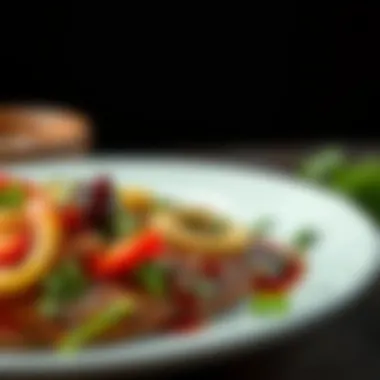
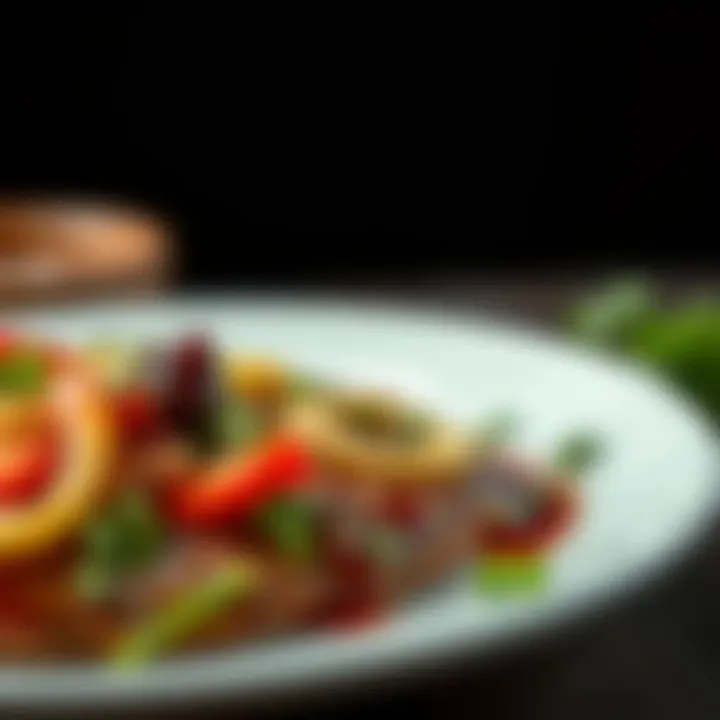
Intro
Navigating the world of gluten-free dining can seem like trawling through a maze—challenging yet rewarding for those looking to embrace healthier eating habits. Whether you’re gluten intolerant, living with celiac disease, or simply opting for a gluten-free lifestyle, the kitchen can become your best friend. This guide is tailored specifically for those eager to tackle lunchtime cravings with gusto.
As we dive into an array of gluten-free lunch recipes, expect to explore a myriad of flavors and textures that can rival traditional meals. It’s not just about exclusion; it’s about inclusion of scrumptious alternatives that put the fun back into lunch! Imagine biting into a tender wrap made from quinoa instead of wheat, or enjoying a hearty salad topped with roasted chickpeas tossed in zesty spices. The journey ahead is filled with exciting possibilities.
"The secret of good cooking is, first, having a love of it. If you love it, you’re going to do it well."
This quote encapsulates the heart of cooking gluten-free meals. With, a little bit of creativity and a dash of enthusiasm, your lunch can transform into a delightful experience. The recipes we delve into will provide not only nourishment but also promote culinary exploration, ensuring you enjoy every bite without compromise.
Stay tuned as we cover key insights, talk about crucial ingredients that fit the gluten-free bill, and break down steps to make your cooking as seamless as possible. Cooking gluten-free doesn’t have to be a grim affair; in fact, it can be just the opposite.
Preamble to Gluten-Free Cooking
Navigating the landscape of gluten-free cooking holds great significance, particularly for those who suffer from celiac disease or gluten sensitivity. It goes beyond merely avoiding wheat, barley, and rye; it’s about embracing a variety of ingredients that can bring health and flavor to meals. Understanding gluten-free cooking opens the door to a world of alternative grains and creative culinary techniques. Not only does it cater to the dietary needs of a growing population, but it also encourages the exploration of diverse flavors and textures.
Being gluten-free isn't just a trend; it’s a lifestyle choice rooted in health and well-being. For many, it can lead to reduced inflammation, improved digestive health, and enhanced overall well-being. A well-thought-out gluten-free diet can provide all the essential nutrients while still being delightful to the palate.
Moreover, gluten-free cooking emphasizes the importance of food diversity. By stepping away from traditional grains, cooks are prompted to experiment with quinoa, amaranth, or even buckwheat. This variety can introduce exciting profiles to any dish, making lunch not just a necessity but a culinary adventure.
Understanding Gluten and Its Impact
Gluten, a protein found in certain grains, has been linked to various health issues. For individuals with celiac disease, consuming gluten can lead to severe health complications, including intestinal damage and nutrient malabsorption. Even those with non-celiac gluten sensitivity may experience discomfort after consuming gluten, including bloating, fatigue, or headaches. Understanding these impacts is crucial for making informed dietary choices.
Often, gluten’s elusive nature can lead to unexpected encounters in processed foods, sauces, and even some vitamins or medications. Consequently, being savvy when reading labels and ingredient lists becomes a necessary habit. More than just a food to avoid, gluten can become a lens through which people can gain better awareness of their diets and health.
"Being gluten-free isn't solely about restriction; it’s an invitation to explore new culinary landscapes."
The Rise of Gluten-Free Diets
In recent years, gluten-free diets have surged in popularity, transcending beyond just those diagnosed with gluten-related disorders. This rising trend can be attributed to growing awareness about health and nutrition. Many claim that gluten-free meals can improve energy levels and overall health, and thus the gluten-free sector has rapidly expanded in grocery stores and restaurants alike.
Consumer demand has led to a boom in gluten-free products. Items once considered niche, such as gluten-free breads, pastas, and snack foods, now fill shelves in grocery aisles. Restaurants too have adapted, actively altering their menus to cater to the gluten-free crowd, offering a wider range of options than ever before.
This widespread adoption, however, comes with its own set of challenges. As gluten-free cooking gains traction, it’s crucial for enthusiasts to discern between genuinely healthy gluten-free foods and those heavily processed alternatives that do not contribute much nutritionally. This realization leads to a more informed consumer, one who not only seeks flavor but also nutritional value.
In sum, the exploration of gluten-free cooking is not merely about replicating traditional dishes without gluten; it’s an opportunity to innovate, bring attention to nutritious ingredients, and embrace the diverse world of flavors available outside the traditional gluten-laden scope.
Nutritional Considerations
Nutritional considerations play a central role in managing a gluten-free diet, particularly for individuals who have celiac disease or non-celiac gluten sensitivity. When guiding food lovers through the intriguing landscape of gluten-free lunches, it becomes essential to dissect the nutritional ramifications of eliminating gluten. A well-balanced gluten-free meal does not just avoid wheat; it offers a plethora of flavors, textures, and health benefits.
One significant aspect is understanding how to ensure that meals remain nutritious while adhering to gluten-free standards. This means being vigilant about including essential vitamins, minerals, and macronutrients. Many gluten-free grains and flours lack fiber and certain B vitamins found in whole grains. Hence, it’s crucial to choose diverse sources of nutrients that bolster overall health.
Essential Nutrients in a Gluten-Free Diet
When transitioning to a gluten-free diet, individuals should prioritize essential nutrients that might otherwise be scarce. Here’s a closer look at some of the key players:
- Fiber: Important for digestive health, fiber can sometimes take a hit in gluten-free diets. Opting for fruits, vegetables, legumes, and gluten-free whole grains like quinoa or brown rice can help restore the balance.
- B Vitamins: These are vital for energy metabolism and overall functioning. Foods like leafy greens, nuts, and seeds can fulfill these requirements quite well. Gluten-free fortified cereals can also be a practical choice.
- Iron: This mineral is crucial, especially for those who do not consume red meat. Incorporate sources like lentils, chickpeas, and spinach to cover these needs.
To enhance the nutritional value, experiment with ingredients like almond flour or coconut flour, which can add not just flavor but extra nutrients as well.
Common Mistakes to Avoid
Navigating the gluten-free diet can open up a world of culinary possibilities, but it’s also fraught with pitfalls that can hinder nutritional intake. Here are some common missteps:
- Relying Too Heavily on Processed Gluten-Free Products: Many packaged gluten-free items can be high in sugar and low in nutritional value. Reading labels carefully is essential to avoid unhealthy ingredients.
- Neglecting Fruits and Vegetables: A common oversight is skipping fresh produce in favor of gluten-free substitutes. Filling your plate with vibrant vegetables not only offers essential nutrients but also adds color and variety.
- Ignoring Whole Grains: Swapping out wheat-based products for refined gluten-free grains can lead to a lack of fiber. Whole gluten-free options should be prioritized for better health outcomes.
"Understanding nutritional considerations is not just about avoiding gluten, but about embracing a colourful, diverse range of foods that nourish the body."
Adaptation is key to a successful gluten-free lifestyle. Keeping an eye on nutritional composition while savoring your meals can turn any lunch into a gratifying experience that nourishes both body and soul.
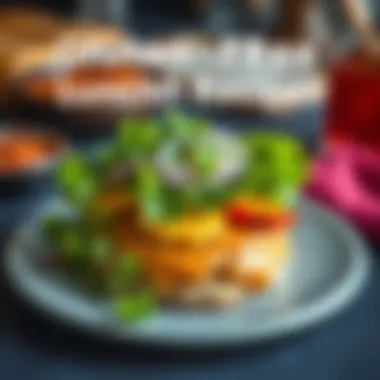

Key Ingredients for Gluten-Free Lunches
Understanding the pivotal ingredients that form the backbone of gluten-free lunches is essential in creating meals that not only taste great but also nourish the body. The rise in popularity of gluten-free diets means more than just a trend; it's about recognizing the need for diverse and nutritious options that cater to different dietary restrictions. Knowing what key ingredients to use empowers meal preparations to be both satisfying and fulfilling.
Gluten-Free Grains and Alternatives
When it comes to grains, opting for gluten-free varieties is key to maintaining a balanced diet without the harmful effects of gluten. Popular gluten-free grains include quinoa, rice, millet, and buckwheat. Each of these grains is packed with nutrients, offering various vitamins and minerals. For instance, quinoa is not only gluten-free but also a complete protein, which means it provides all nine essential amino acids. Something like brown rice can pair beautifully with different ingredients, making it a versatile option for bowls or stir-fries.
Furthermore, many folks aren't aware of fantastic alternatives like sorghum or teff, which add unique flavors and textures to dishes. It's wise to experiment with these grains, as their culinary diversity can lead to surprisingly delightful gourmet experiences.
"A diet without gluten is not a restriction; it’s an invitation to get creative in the kitchen."
Fruits, Vegetables, and Proteins
Fruits and vegetables are the heart of any meal, gluten-free or not. Incorporating a colorful array of seasonal fruits and vegetables not only provides essential vitamins and minerals but can also elevate the aesthetic appeal of your lunch. Think of robust greens like kale or vibrant bell peppers that not only look good but provide a punch of flavor. They can be sautéed, roasted, or tossed in a fresh salad, delivering both taste and nutrition.
Proteins are just as vital. Options like chicken, tofu, or hard-boiled eggs can easily complement a variety of dishes. Legumes such as chickpeas and lentils serve as incredible protein sources, rich in fiber and fulfilling. When creating a lunch, consider how to balance flavors and textures—crunchy vegetables, creamy avocado, and succulent proteins can work together to create a symphony on a plate.
Dairy and Non-Dairy Options
Dairy and non-dairy options give one the flexibility to cater to various tastes and dietary needs. For those who enjoy dairy, products like plain Greek yogurt or cheese can be excellent additions. Greek yogurt is versatile enough to be drizzled over grains or used in dressings. However, for those who prefer non-dairy alternatives, options like almond milk, coconut yogurt, and cashew cream can bring richness to lunch without the lactose.
Many dairy substitutes also have less fat or fewer calories, often adding only flavor without the heaviness. In recipes that call for creamy elements, such as sauces or dressings, these alternatives can still deliver that desired consistency and mouthfeel.
In summary, building a repertoire of gluten-free ingredients is about more than just adhering to dietary restrictions; it’s about creativity and health. With the key components identified—grains, produce, and proteins—preparing exciting gluten-free lunches can become an enjoyable ritual rather than a chore.
Step-by-Step Gluten-Free Lunch Recipes
Creating gluten-free lunches that are both satisfying and delicious is not only feasible but can also be an enjoyable experience. This section aims to show readers how to put together meals that fit their dietary choices without sacrificing flavor or variety. A well-planned gluten-free lunch can ensure sustained energy and nutrition throughout the day, especially important for busy lifestyles. Plus, exploring these recipes provides an opportunity to discover new ingredients and culinary techniques.
Salads: Refreshing and Nourishing
Salads are often seen as a healthy option, but they can be so much more than just a side dish. They can serve as a filling main course, packed with nutrients and flavor.
Quinoa Salad with Roasted Vegetables
In the case of the quinoa salad with roasted vegetables, this dish stands out for its versatility and richness. Quinoa, a pseudo-grain, offers complete protein, making it a fantastic foundation for a nutritious meal. The addition of roasted vegetables not only enhances the flavor but also adds important vitamins and minerals.
The key characteristic of this salad is its ability to be customized based on seasonal vegetables. Whether it's bell peppers in summer or root vegetables in fall, the options are plentiful. This salad is a popular choice as it ticks off many boxes—gluten-free, vegan, and packed with fiber. The unique feature of this dish is that it can be made in advance; the flavors meld wonderfully when it sits, making it ideal for meal prep. However, one downside is that left overs should be consumed within a couple of days to avoid sogginess.
Spinach and Chickpea Salad with Lemon Dressing
This salad lifts the spirits with its vibrant colors and refreshing taste. Spinach is a leafy green powerhouse, while chickpeas offer a hearty texture and boost of protein. The lemon dressing brightens the dish and adds a zesty kick, making it a refreshing lunch option.
The main appeal of the Spinach and Chickpea Salad is how quickly it can be assembled, making it perfect for those on the go. Not only is it nutritious, but it’s also visually appealing—an important aspect when preparing a meal. A unique feature of this salad is how adaptable it is; one can easily swap in different legumes or greens based on what’s available. On the flip side, fresh spinach can wilt quickly if dressed too early, which necessitates proper timing when preparing the dish.
Wraps and Sandwiches
Wraps and sandwiches serve as convenient lunch options that offer endless combinations of fillings, ensuring no two meals are ever the same.
Stuffed Lettuce Wraps with Grilled Chicken
For those looking to enjoy a protein-packed meal, stuffed lettuce wraps with grilled chicken are a top-notch choice. These wraps avoid bread and instead use lettuce leaves, making them incredibly light and refreshing. Additionally, they provide a perfect vehicle for all sorts of flavors and textures.
The standout element here is the crispness of the lettuce combined with juicy grilled chicken. This dish is beneficial for health-conscious eaters as it is low in carbs but high in protein. The unique feature is the ease of preparation; grilling chicken in large batches allows for quick assembly on busier days. However, if not consumed promptly, the lettuce can become limp, so timing is vital when serving these wraps.
Gluten-Free Tortilla Wraps with Hummus and Veggies
These gluten-free tortilla wraps with hummus and veggies hit a home run for flavor and simplicity. The base of a gluten-free tortilla allows for a soft, pliable wrap that holds plenty of fillings. Hummus serves as a creamy spread while adding nutrients from chickpeas.
This dish is notably versatile; one can use a range of vegetables, from cucumbers to bell peppers, allowing for seasonal adjustments. The key characteristic lies in its balanced approach to taste and nutrition. A unique aspect is the option to add spices or herbs to the hummus for added depth. However, if one isn’t careful, the wraps can tear if overstuffed, leading to a messy lunch experience.


Bowl Meals for Balanced Nutrition
Bowl meals combine various ingredients into one harmonious dish, providing a well-rounded meal that includes all essential components.
Brown Rice Bowl with Avocado and Black Beans
The brown rice bowl featuring avocado and black beans is notable for its heartiness. Brown rice serves as a whole grain base that is both filling and nutritious. Healthy fats from avocado complement the protein of black beans, creating a meal that’s energizing and satisfying.
What makes this bowl a great choice is its ease and scalability. One can modify it based on what’s in the fridge—a truly adaptable recipe. Additionally, each ingredient offers unique health benefits, from fiber to essential fatty acids. One drawback is that if prepared ahead of time, one needs to ensure the avocado is not added too early, or it will brown.
Zucchini Noodle Bowl with Pesto and Shrimp
For a lighter option, the zucchini noodle bowl with pesto and shrimp brings a different flair. Zucchini noodles provide a low-carb alternative to traditional pasta, making it a great gluten-free choice. The shrimp adds protein, and the vibrant pesto ties the dish together.
This option is especially popular among those seeking to reduce their carbohydrate intake while still enjoying a comforting meal. The unique feature includes the vivid colors and freshness of zucchini paired with the aromatic flavor of pesto. One potential drawback, however, is that zucchini noodles can become watery if cooked for too long, so a light sauté is all that’s needed to keep them crisp.
In summary, these step-by-step recipes exemplify the potential of gluten-free lunches. They not only offer nutritional benefits but also encourage creativity in the kitchen, appealing to food lovers of all ages. Every dish tells a story through its ingredients, and with a little preparation, they can transform everyday lunches into delightful culinary adventures.
Flavor Enhancements and Seasoning
Flavor enhancements are the backbone of any well-crafted dish, but they hold particular importance in the realm of gluten-free cooking. When gluten is taken out of the equation, it’s easy for meals to come off as bland or unexciting. This is where the right combination of herbs, spices, dressings, and sauces can elevate a simple gluten-free lunch into something truly remarkable. Using these elements thoughtfully not only adds depth to flavors but also contributes to a satisfying dining experience. In this section, we will explore how elements like herbs and spices can be used to inspire the palate and make gluten-free lunches anything but boring.
Herbs and Spices to Elevate Dishes
When it comes to flavor enhancement, herbs and spices are the stars of the show. They are powerful tools that can transform an ordinary dish into a culinary experience. Here are some notable options:
- Basil: A sweet, aromatic herb often used in Mediterranean dishes. Fresh basil can brighten up salads or become a fragrant topping on gluten-free pasta.
- Cumin: Earthy and warm, cumin is a staple in many global cuisines, especially Indian and Middle Eastern. Sprinkle it on roasted vegetables for a flavor boost.
- Smoked Paprika: This adds a smoky depth and essential warmth, great for stews or as a seasoning on grilled items.
- Oregano: Especially in tomato-based recipes, oregano can really round out the flavor profile. Use it in marin marinades or dressings to give a Mediterranean flair.
- Cilantro: With its citrusy undertones, cilantro works wonders in salsas and green sauces, keeping things fresh and vibrant.
"Spices don't just flavor food; they transform it into something extraordinary. When cooking gluten-free, don't shy away from bold choices."
Bringing these herbs and spices into gluten-free dishes enhances their appeal and adds a nutritional punch, as many herbs and spices come packed with antioxidants
Homemade Dressings and Sauces
Homemade dressings and sauces are not only free from hidden gluten but also allow one to control what goes into them. Store-bought options can sometimes contain additives and preservatives, sneaking in unwanted ingredients. Making your own can open up a world of flavors, tailored to your taste.
Here are a few dressing and sauce ideas that can amplify your gluten-free lunches:
- Lemon Vinaigrette: A simple mix of lemon juice, olive oil, salt, and pepper can lighten up salads or grilled veggies in no time.
- Avocado Dressing: Blend ripe avocado with yogurt or a dairy-free alternative, garlic, lime juice, and salt for a creamy, nutrient-rich sauce that goes well on almost everything.
- Peanut Sauce: A mix of peanut butter, tamari (a gluten-free soy sauce), lime juice, and a bit of garlic can make a tasty dip for veggies or a drizzle over rice bowls.
- Pesto: Traditional basil pesto made with olive oil, garlic, pine nuts, and parmesan is a great addition to any gluten-free pasta dish. You could also use spinach or kale as a base for something a little different.
Creating these homemade options can also be an expression of culinary creativity, allowing you to experiment with flavors that speak to you.
This emphasis on seasoning and flavor enhancement not only rejuvenates pantry staples but also makes gluten-free dining vibrant and satisfying.
Meal Prep for Busy Lifestyles
In today’s fast-paced world, maintaining a balanced diet while juggling work, family, and social commitments can be quite the challenge. This is where meal prep comes into play, especially for those adhering to a gluten-free lifestyle. It not only saves time but also allows for careful control over ingredients and portion sizes. Planning ahead is key. By dedicating a few hours each week to meal preparation, you can craft a variety of gluten-free lunches that are both nutritious and flavorful.
Batch Cooking Gluten-Free Components
Batch cooking refers to the practice of preparing large quantities of specific ingredients in one go. This approach can simplify the cooking process dramatically. For instance, think about crafting a big pot of quinoa or a batch of roasted vegetables on a Sunday evening. The beauty lies in versatility; these components can serve as the building blocks for several meals throughout the week.
- Consider cooking staples like:
- Brown rice
- Lentils
- Chickpeas
- Grilled chicken
Once these components are ready, they can easily be assembled into different dishes, keeping things fresh without extensive daily cooking. Say you roast a mix of bell peppers, zucchini, and sweet potatoes; these can beautify your salads, wraps, or bowls without much fuss. It’s a matter of combining them in various ways to suit your taste buds.
Storing and Reheating Tips
How you store and reheat your prepped meals can make a world of difference in maintaining flavor and texture. The key lies in using the right containers and methods.
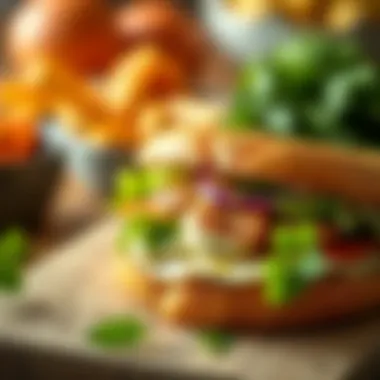
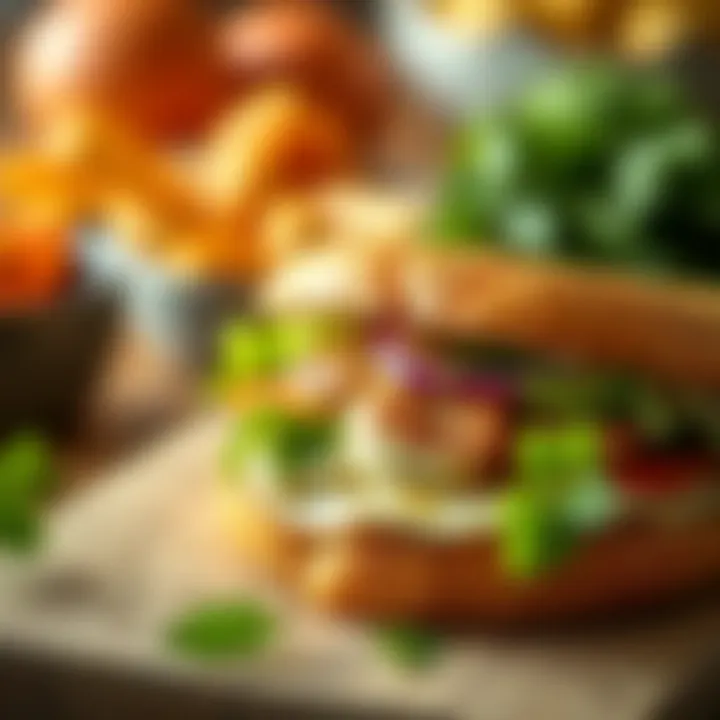
Opt for airtight containers that prevent moisture and air from spoiling your meals. Glass containers work well as they can handle temperature changes—perfect for popping into the oven or microwave. Here are some handy tips for storage and reheating:
- Label and Date: Always label your containers with the contents and the date it was cooked to keep track of freshness.
- Separate Sauces: If you’re prepping meals that involve sauces or dressings, store them separately to prevent sogginess.
- Reheat Smartly: Instead of blasting your meal in the microwave, consider reheating on the stovetop to retain texture. A little splash of water in the pan can help steam the food, making it feel freshly cooked.
A Final Word
Meal prep isn’t just about convenience; it’s a strategy that allows you to make mindful food choices while embracing the joy of gluten-free eating. Taking time during the week to prep can also serve as a creative outlet, transforming mundane cooking into an exciting weekly ritual.
Exploring Global Cuisines
Exploring various global cuisines can breathe new life into gluten-free lunch recipes, providing a treasure trove of flavors and textures. Each culture offers unique ingredient combinations and cooking methods that make gluten-free eating not just possible, but delightful. By tapping into global cuisines, you can discover new favorites and maybe even impress your palate with exiting dishes that you’d never considered before.
When you venture into international flavors, there’s an opportunity to broaden your culinary repertoire. This exploration can lead to meals that aren’t only gluten-free but also rich in nutrients and absolutely satisfying. It's all about substituting traditional gluten-laden components with ingenious alternatives, ensuring no flavor is lost in translation.
Mediterranean-Inspired Dishes
Mediterranean cuisine is a cornucopia of flavor, bursting with fresh produce, beans, and nuts. It’s naturally inclined towards gluten-free options because many traditional dishes include ingredients like olive oil, herbs, and seasonal vegetables instead of wheat-based products.
For a simple yet delicious Mediterranean-inspired gluten-free lunch, consider making a chickpea salad, packed with diced cucumbers, cherry tomatoes, red onion, and a zesty lemon-olive oil dressing. This dish isn’t just hearty but also light enough to keep you from feeling sluggish.
Some other dishes to explore include:
- Shakshuka: A savory egg dish that uses tomatoes and spices, often served with gluten-free bread.
- Roasted Vegetable Platter: With eggplant, peppers, and zucchini drizzled in tahini sauce, it's a canvas for all your favorite colors.
- Grilled Chicken Skewers: Marinated in Mediterranean spices and served with a yogurt dip, these skewers can be paired with rice or quinoa for extra heartiness.
Asian Flavors without Gluten
Asian cuisine offers a myriad of gluten-free options, centered around rice, vegetables, meats, and a multitude of flavors from soy sauce alternatives. In Thai cooking, for example, tamari (a gluten-free soy sauce) replaces traditional soy sauce seamlessly.
A popular Asian-inspired dish to try is a rice noodle stir-fry. You can toss rice noodles with your favorite vegetables, proteins like shrimp or tofu, and a splash of tamari to elevate the entire dish. It’s quick, colorful, and it allows room for creativity.
Here are some additional ideas for Asian-inspired gluten-free lunches:
- Buddha Bowls: Layered with rice or quinoa, assorted veggies, and a flavorful miso dressing.
- Thai Curry: Made with coconut milk and served with steamed jasmine rice, it's comforting and nourishing.
- Sushi Rolls: Using rice and fillings such as avocado, cucumber, and crab, rolled with seaweed can be an adventurous yet satisfying meal.
Latin American Influences on Gluten-Free Lunches
Latin American cuisine is a gift that keeps on giving when it comes to gluten-free meals. Many traditional dishes include corn, beans, and fresh produce, making it easy to enjoy vibrant flavors without the gluten.
One standout dish is the corn tortillas. You can create tacos filled with grilled vegetables, seasoned meat, or beans, topped off with fresh salsa and avocado. These tacos aren’t just filling, but they also pack a flavor punch.
Consider the following Latin American-inspired gluten-free lunch options:
- Ceviche: Fresh fish marinated in citrus juices, combined with onions and cilantro, perfect as a light lunch.
- Quinoa Salads: Spiced with cumin, topped with black beans and fresh mango, they offer a refreshing dish.
- Arepas: Made from corn dough, these can be filled with various ingredients such as cheese, avocado, or shredded meats.
Exploring these global cuisines not only brings exciting tastes to the table but also promotes a sense of inclusivity and innovation in your gluten-free cooking. By embracing these international flavors, you can enjoy gluten-free lunches that are as diverse and enriching as the cultures they come from.
Epilogue
Benefits of Embracing Gluten-Free Lunches
Transitioning to gluten-free lunches isn’t merely about avoiding wheat, barley, and rye. It’s about embracing a diverse range of ingredients that can enhance your diet:
- Nutritional Variety: Gluten-free meals often incorporate a wide variety of fruits, vegetables, legumes, and grains like quinoa and brown rice. This variety can lead to a more balanced diet.
- Enhancing Flavor: Many gluten-free recipes utilize spices and fresh herbs to create rich flavors, without the need for gluten-containing ingredients. Ingredients like turmeric, basil, and cumin can transform a meal from bland to grand.
- Culinary Creativity: Going gluten-free inspires cooks to think outside the box. Substitutions can often lead to new family favorites that they may not have tried otherwise.
Considerations for Gluten-Free Lunches
While the transition can be rewarding, it’s crucial to consider the potential pitfalls:
- Cross-contamination: For those with celiac disease or severe gluten intolerance, even trace amounts of gluten can cause health issues, necessitating careful meal preparation and storage.
- Nutritional Gaps: Some gluten-free products can be lower in fiber and certain vitamins, making it essential to choose whole foods.
- Reading Labels: Not all gluten-free labeled foods are healthy. It's always a good idea to check the ingredient list and opt for foods that are less processed.
“Adapting to a gluten-free lifestyle is not an end, but a beginning to explore new flavors and textures.”
Final Thoughts on Embracing Gluten-Free Lunches
Ultimately, embracing gluten-free lunches opens pathways to better health and enhances one’s culinary skills. It’s about creating meals that cater to dietary needs while remaining exciting and fulfilling. Armed with the knowledge of gluten-free ingredients and diverse recipes, anyone can craft satisfying lunches that fit their lifestyle. The recipes explored within this article serve as a foundation, which can inspire culinary enthusiasts to experiment and personalize their meals.
The journey into gluten-free cooking may seem daunting at first, but it truly blossoms into a celebration of flavors, colors, and healthy eating.







